Abstract
This paper investigates the seismic performance of thin-walled stiffened steel square box columns, modeling bridge piers subjected to unidirectional cyclic lateral loading with a constant axial load, focusing on local, global, and local-global interactive buckling phenomena. Initially, the finite element model was validated against existing experimental results. The study further explored the degradation in strength and ductility of both thin-walled and compact columns under cyclic loading. Thin-walled, stiffened steel square box columns exhibited buckling near the base, forming a half-sine wave shape. The research also addresses discrepancies from different material models used to analyze steel tubular bridge piers. Analysis using a modified two-surface plasticity model (2SM) yielded results closer to experimental data than a multi-linear kinematic hardening model, particularly for compact sections. The 2SM, which accounts for cycling within the yield plateau and strain hardening regime, demonstrated enhanced accuracy over the multi-linear kinematic hardening model. Additionally, a parametric study was conducted to assess the impact of key design parameters—such as width-to-thickness ratio (Rf), column slenderness ratio (λ), and magnitude of axial load (P/Py)—on the performance of thin-walled stiffened steel square box columns. Design equations were then developed to predict the strength and ductility of bridge piers. These equations closely matched experimental results, achieving an accuracy of 95% for ultimate strength and 97% for ductility.
1. Introduction
Thin-walled steel box columns, commonly used as bridge piers, are vital to urban transportation infrastructure. Structural hollow sections offer several advantages over open sections, such as enhanced aesthetic appeal, excellent flexural resistance about all axes, and superior torsional rigidity. These features make them ideal for various applications, including columns in buildings, members in lattice girders, and bridge piers.
Typically produced through cold-forming techniques [1,2,3], thin-walled steel box columns are created by welding steel sheets longitudinally to form the final section profile without prior heating or subsequent heat treatment. This method not only improves structural performance but also provides an economical solution for withstanding instability due to severe environmental loads, such as seismic forces [4,5,6].
Research on the local [7,8,9,10,11,12,13] and global [14,15,16,17,18,19,20,21,22] buckling of cold-formed hollow sections is extensive. While some studies have explored the interaction between local and global buckling in welded box sections [23,24,25], research on cold-formed tubular members with slender cross-sections remains limited [26,27,28,29,30].
Steel bridge piers with box sections are generally designed as single cantilever columns or one- to three-story frames. Highway bridge systems frequently utilize thin-walled members with closed-box cross-sections due to their high strength and torsional rigidity. These structures differ markedly from building columns, often failing due to local buckling in thin-walled members, irregular distribution of story mass and stiffness, strong beams and weak columns, low rise (one to three stories), and the need for residual displacement evaluations. Consequently, thin-walled steel box columns in bridge piers are particularly susceptible to damage from local and overall interaction buckling during severe earthquakes [31,32,33,34].
For example, Figure 1 depicts the performance of thin-walled steel box section bridge piers during the Hyogoken-Nanbu earthquake near Kobe City, Japan, on 17 January 1995. The steel bridge piers with rectangular box sections experienced collapse, weld seam tear-outs, and severe local buckling damage, as shown in Figure 1 [32,33]. Local buckling was observed near the base of the column (Figure 1c).
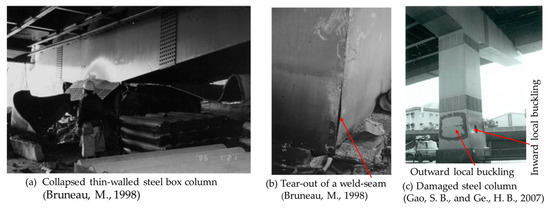
Figure 1.
The performance of the thin-walled steel box section bridge pier was during the Hyogoken-Nanbu earthquake near Kobe City, Japan, on 17 January 1995: (a) Collapsed thin-walled steel box column [32], (b) Tear-out of a weld-seam [32], (c) Damaged steel column [33].
Post-Kobe earthquake research has increasingly focused on steel tubular columns with various cross-sections subjected to constant axial loads and cyclic lateral loads in one or multiple directions. To enhance the seismic capacity of steel bridge piers with tubular box sections, researchers have investigated both experimentally and theoretically the stability and plastic ductility of steel tubular columns [31,32,33,34,35,36,37,38,39,40,41,42,43,44,45,46,47,48,49,50,51,52]. The strength of these tubes is influenced by local buckling of the tube walls, which depends on the slenderness of the plate elements forming the tube. Local buckling patterns in rectangular or square bare steel tubes can include inward and outward buckles (see Figure 1c), which are considered in major steel design specifications.
Thin-walled steel tubular columns typically experience local buckling near the base at heights corresponding to the diameter and width of circular and square thin-walled columns, respectively [2,32,33,34,35,36]. Research indicates that the ability of these piers to withstand severe earthquakes depends heavily on their strength and ductility [2,15].To improve seismic performance, studies have explored incorporating stiffeners and diaphragms to enhance both strength and ductility [2,6,39,40].
In response to the damage observed in steel bridge piers during the Kobe earthquake, a critical consideration in the seismic design and retrofit of steel tubular columns is to increase ductility while maintaining nearly unchanged ultimate strength [2,31]. Therefore, understanding the cyclic inelastic behavior of thin-walled steel tubular columns is essential for developing rational performance-based seismic design methodologies and evaluating ductility.
Finite element analysis (FEA) of thin-walled steel tubular columns has utilized both isotropic and kinematic hardening material models for cyclic analysis. The kinematic hardening model generally aligns better with test data compared to the isotropic hardening model [47,49,51]. However, it may overestimate strengths under cyclic loading [50]. To improve numerical accuracy, further investigation into additional material models, such as those implemented through ABAQUS-UMAT subroutines in FE ABAQUS 2023 software [52], is necessary. Recent advancements, particularly in Japan, have introduced alternative material models that better replicate test results, such as the fiber-based model with a failure segment [47].
FE analysis of cyclic behavior involves solving a system of non-linear equations derived from applied nodal forces and internal equivalent nodal forces [53,54,55]. The constitutive material model of structural steel is described using incremental plastic theory, which includes strength rules, yield criteria, flow rules, and criteria for plastic loading and unloading [56,57,58]. Accurate finite element methods are crucial for predicting the cyclic behavior of these structures. The modified two-surface plasticity model (2SM), developed by Mamaghani et al. [6,58,59], which accounts for cyclic strain hardening and the reduction of the yield plateau and elastic range (Bauschinger effect) due to cyclic loading, was employed in the commercial software ABAQUS 2023 (ABAQUS-2SM).
This study aims to thoroughly investigate the stability behavior of cold-formed hollow steel box sections subjected to cyclic lateral loads combined with axial compression, focusing on local, global, and local-global interactive buckling phenomena. Thin-walled, stiffened steel square box columns are susceptible to damage from local buckling, global buckling, or a combination of both. Local buckling is influenced by the width-to-thickness ratio (Rf) of the flange plate, while flexural buckling is determined by the column’s slenderness ratio (λ) [2]. Extreme seismic loads can cause significant damage or collapse due to these buckling modes [32,33]. Large earthquakes generate substantial cyclic lateral loads, necessitating precise design parameters. This study employs ABAQUS-2SM to validate the inelastic cyclic behavior of thin-walled, stiffened steel square box columns [45]. A parametric analysis assessed key design parameters, including steel material modeling, diaphragms, stiffeners, the width-thickness ratio for the flange (Rf), and the column slenderness ratio (λ). The study developed interaction equations for these parameters, facilitating a safe and cost-effective design approach for thin-walled, stiffened steel square box columns used in bridge piers.
2. Characteristics of Thin-Walled Stiffened Steel Square Box Columns
Thin-walled stiffened steel square box columns modeling bridge piers are designed by monitoring specific ranges for various parameters: the width-to-thickness ratio for the flange (Rf), the slenderness parameter (λ), and the axial force parameter (P/Py). Where Py is the squash load of the column. The following equations describe these parameters [44]:
where, d = column depth (square section size), h = column height, t = plate thickness, v = Poisson’s ratio, E = modulus of elasticity, σy = yield strength, n = the number of sub-panels separated by the stiffeners [44,47].
A series of experiments on thin-walled, stiffened steel square box columns has been conducted by [44,48]. Based on these experiments, the practical values for Rf for the thin-walled stiffened steel square box columns have been proposed in the range of 0.2 to 0.5, with the axial load not exceeding 20% of the yield load [39,47]. A schematic diagram of the thin-walled, stiffened steel square box column is illustrated in Figure 2a,c.
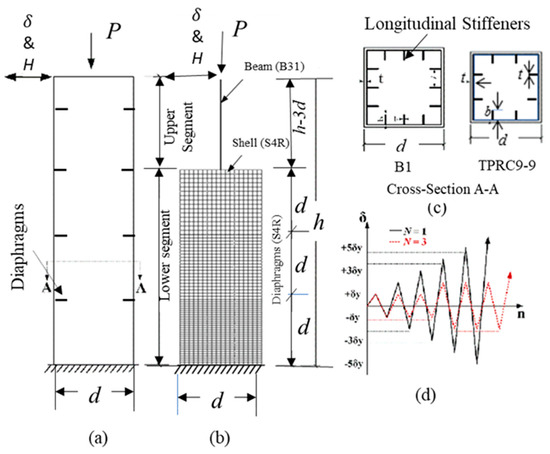
Figure 2.
Finite Element Modeling (a) Column, (b) FE Meshing, (c) Stiffened Cross-section, and (d) Loading Path Protocol.
3. Finite Element Analysis
In this study, the results from two tested columns available in the literature—the TPRC9-9 column [43] and the B1 column [3]—were used to validate the finite element modeling with the 2SM model for material nonlinearity [58]. The modeling was conducted using ABAQUS [52] employing the 2SM for material nonlinearity [58], hereafter referred to as ABAQUS-2SM.
As shown in Figure 2c, the column features eight longitudinal stiffeners for the TPRC9-9 column and twelve longitudinal stiffeners for the B1 column, each 6 mm thick and 60 mm wide, and two diaphragms, spaced 450 mm apart and 6 mm thick. The cross-sectional plate thickness is 9 mm for both the flange and the web. Table 1 lists the material and geometric properties of the analyzed specimens.

Table 1.
Geometric and material parameters for the specimens.
3.1. Brief Description of the 2SM Model
The 2SM model can more effectively capture the cyclic behavior of structural steel compared to existing material models, as it incorporates the yield plateau and explicitly accounts for its reduction and eventual disappearance under cyclic loading [6,58]. A detailed description of the 2SM and its application to simulating the cyclic behavior of structural steel is provided by Shen et al. [58]. This model requires more constants than the multi-linear kinematic hardening (MKH) model, totaling 18 parameters: 5 material constants (σy, E, ν, εstp, and Est) and 13 model parameters [6,58]. Here, εstp represents the plastic strain, and Est denotes the initial hardening modulus at the end of the yield plateau. The 13 model parameters were calibrated using experimental data from a simple load test on a steel section [6,58].
The cyclic behavior of structural steel with a yield plateau influences the constitutive model based on the principles of time-independent plasticity theory. This model employs a Von Mises yield surface in conjunction with an associative flow rule [58]. The flow rule is described by the following equations:
In these equations, bold letters represent second-order tensors, εp represents the plastic strain tensor, σ represents the stress tensor, ζ is the stress deviator, ƞ is the back stress, ρ is the initial size of the yield surface, k is the size of the yield surface, R is the isotropic hardening/softening variable, ξ is the plastic multiplier, p is the accumulated plastic strain, and the double dot represents the inner product [6,58]. Although the stiffeners and diaphragms have different geometric properties, they share the same material properties as the column’s component plate. The 2SM model is also applied to these components since they are integral to the column and affect its buckling behavior.
3.2. Loading Description
Strength and ductility analysis of bridge piers typically involves evaluating their performance under various loading conditions, including axial, monotonic, and cyclic loads. Axial loading applies a force along the axis of the bridge pier, simulating dead loads, live loads, and other service loads within the bridge [54]. Monotonic lateral loading involves the gradual application of force or displacement in a single lateral direction without reversal.
Cyclic lateral loading, which represents the horizontal component of seismic excitation, can be either force-controlled or displacement-controlled. This loading involves increasing the lateral load or displacement by integer multiples of the initial yield load or displacement in alternating directions. Experimentally, cyclic loading is commonly applied using a push-pull hydraulic jack [39]. In this study, a unidirectional displacement-controlled cyclic loading protocol is used, as illustrated in Figure 2d. The solid line represents one-cycle loading (N = 1), while the dashed line denotes three-cycle loading (N = 3). During the loading history, a quasi-static cyclic lateral displacement (δ) is applied to the top of the column, accompanied by a constant axial force (P), see Figure 2a. The amplitude of the cyclic displacement is incrementally increased in multiples of the yield displacement (δy), which is defined by Equation (7).
Equation (8) is used to calculate the lateral yield load (Hy), where A, h, E, I, and S represent the cross-sectional area, height, Young’s modulus, the moment of inertia of the cross-section, and the elastic section modulus of the column, respectively [6,44].
3.3. FE Meshing
In thin-walled, stiffened steel square box columns, excessive local deformation can inhibit stress redistribution. Test results indicate that local buckling typically occurs near the column base over a region approximately equal to the cross-sectional size (d) [3,44,46]. To address this, a two-node beam element (B31) is used for the upper segment of the column, with a height of h − 3d, while reduced integration four-node shell elements (S4R), which effectively capture localized deformation, are applied to the lower segment, with a height of 3d, as shown in Figure 2b. The interface between the shell (S4R) and beam (B31) elements is modeled using a multi-point constraint (MPC). The elements used are available in the Abaqus/Standard library [52].
For computational efficiency and accuracy, the bottom and middle portions of the lower segment of the column (equal to the side width, d) are, respectively, divided into 30 and 20 S4R elements, while the remaining height (d) is divided into 15 elements, with an additional 20 elements used in the width direction for the lower segment, see Figure 2b. The upper segment of the column, with a height of h − 3d, is divided into beam elements (B31), each sized at 90 mm. Finally, each longitudinal stiffener and subpanel between the stiffeners, respectively, have 3 and 6 columns of S4R. These mesh sizes were optimized through trial and error to ensure efficient and accurate results. A default of five integration points through the thickness of the S4R element is used. The analysis employs a displacement convergence criterion with a tolerance of 10−5. Initial geometric imperfections and residual stresses are not considered, as these were not quantified in the tested columns [3,43]. Additionally, these factors are believed to have a negligible influence on the overall cyclic behavior after the first half-cycle [6,31]. Further details on elastoplastic large displacement analyses are provided in [6].
4. Numerical Results
4.1. FE Model Validation for Column TPRC9-9
Finite element (FE) analysis was performed using both the multi-linear kinematic hardening (MKH) model and the 2SM model, and the results were compared with experimental data for the column TPRC9-9 by Fukumoto et al. [43]. Figure 3a,b compare the test and analysis results for the normalized lateral load versus lateral displacement hysteresis loops and envelope curve, respectively, for the column TPRC9-9. Deformation visualizations are shown in Figure 4a,b, where the buckled shape near the base displays a half-sine wave formation. The ABAQUS-2SM more accurately predicted the strength values compared to the ABAQUS-MKH in the post-buckling range. For thin-walled, stiffened square box columns, the maximum strength predictions were similar for both MKH and 2SM models, but the accuracy diverged beyond this point (in the post-buckling regime). This discrepancy is attributed to the 2SM model’s superior ability to predict the cyclic elastoplastic behavior of structural steel [58] used in the analysis.

Figure 3.
(a) Hysteresis curve for column TPRC9-9 (b) Envelope curve for column TPRC9-9.
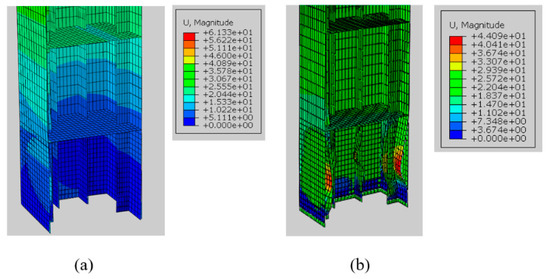
Figure 4.
Buckling of column TPRC9-9: (a) ABAQUS-MKH model (b) ABAQUS-2SM model.
4.2. Model Validation for Column B1
Column B1, as reported in the literature [3], was also used to validate the 2SM model against experimental results. The comparison of results from the ABAQUS-2SM model and the multi-linear kinematic hardening (ABAQUS-MKH) model is shown in Figure 5a,b. The ABAQUS-MKH model predicted higher strength values than both the experimental data and the ABAQUS-2SM model. However, the ABAQUS-2SM model provided strength values closer to the experimental results compared to the ABAQUS-MKH model. Figure 6a,b show the comparison of buckling shapes for the two material models. The lower portion of the stiffener exhibited a buckling shape resembling a half-sine wave, while the plates buckled alternately inwards and outwards.
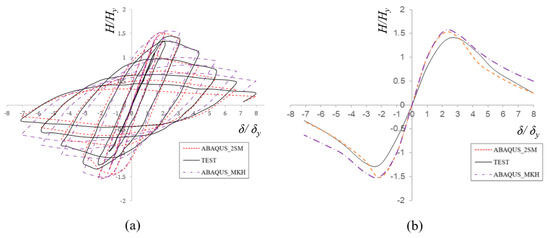
Figure 5.
(a) Hysteresis curve for column B1 (b) Envelope curve for column B1.
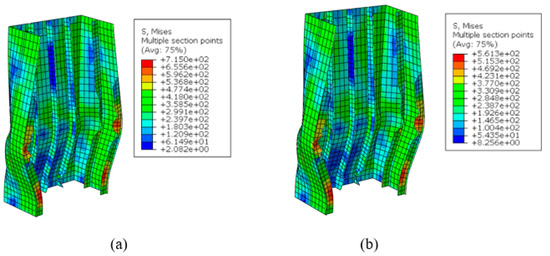
Figure 6.
Buckling of column B1 (a) ABAQUS_MKH (b) ABAQUS_2SM.
4.3. Comparison of Material Model Performance
To evaluate the performance of the 2SM model, further analysis was conducted using a column with compact section properties. The material and geometric properties of this compact section were similar to those of column B1, as detailed in Table 1, except that the plate thickness of the compact section is 25 mm instead of 9 mm. Figure 7a,b show that the MKH model predicted higher strength values for the compact section compared to the 2SM model. This observation suggests that the 2SM model yields more reliable results for FE analysis of compact sections. For the compact column under cyclic lateral loading, material nonlinearity predominates over geometric nonlinearity. Since the 2SM model accurately represents the material characteristics under cyclic loading, it provides a more reliable analysis.
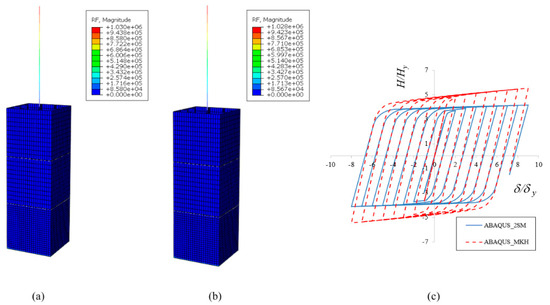
Figure 7.
FE Analysis of a Column with a Compact Section: (a) Deformed Configuration from ABAQUS-MKH, (b) Deformed Configuration from ABAQUS-2SM, (c) Comparison of Hysteresis Loops between ABAQUS-MKH and ABAQUS-2SM.
5. Parametric Study
Using the ABAQUS-2SM, a parametric study was conducted on thin-walled, stiffened steel square box columns to investigate their overall interaction and the impact of key design parameters on their cyclic behavior. The parameters examined include the width-to-thickness ratio (Rf), the column slenderness ratio (λ), and the magnitude of axial load (P/Py). Based on previous studies, the practical ranges for these parameters are: 0.2 ≤ Rf ≤ 0.5, 0.2 ≤ λ ≤ 0.5, and P/Py ≤ 0.2 [39,47].
In this study, the size of diaphragms and stiffeners were kept constant at a thickness of 9 mm, while the web and flange thicknesses were calculated for forty columns by varying Rf and λ values. Details of the column properties used in the parametric study are listed in Table 2. The finite element analysis (FEA) results are summarized in Table 3.

Table 2.
Proposed columns for the parametric study.

Table 3.
Parametric study: strength and ductility evaluation.
5.1. Effect of Width-to-Thickness Ratio Parameter (Rf)
The influence of the Rf parameter on the hysteretic behavior of the analyzed columns was examined. As Rf increased, the thickness of the column decreased. Although the width of the column also affects this parameter, it was kept constant for this study. With λ = 0.29, both the ultimate strength and maximum displacement decreased by 59% and 50%, respectively, as Rf increased from 0.2 to 0.5, as illustrated in Figure 8a,b.
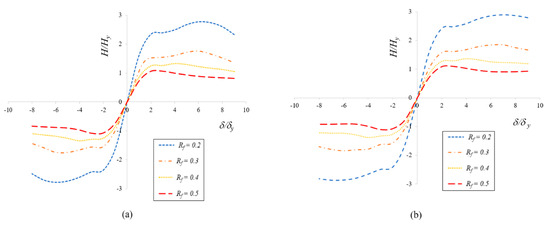
Figure 8.
(a) Envelope curve (λ = 0.29, P/Py = 0.15) (b) Envelope curve (λ = 0.29, P/Py = 0.05).
5.2. Effect of Slenderness Ratio Parameter (λ)
The height of the column is directly proportional to the λ parameter. While the plate thickness of the column remained constant as the λ parameter varied from 0.2 to 0.5, with Rf and P/Py held constant, the height changed from 1563 mm to 3907 mm due to this variation. As shown in Figure 9a,b, both ultimate strength and maximum displacement decreased by 54% and 25%, respectively, when the λ parameter increased from 0.2 to 0.5.
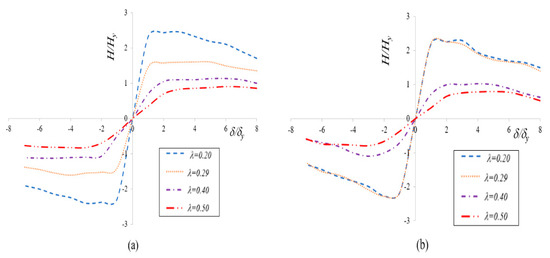
Figure 9.
(a) Envelope curve (Rf = 0.30, P/Py = 0.05) (b) Envelope curve (Rf = 0.30, P/Py = 0.20).
5.3. Effect of P/Py
Envelope curves of the proposed columns were examined under varying axial loads (0 ≤ P/Py ≤ 0.2). As shown in Figure 10, the ratio Hm/Hy decreased with increasing axial load. Although ultimate strength and maximum displacement were only slightly affected as the axial load increased from 0 to 0.2Py, lateral strength and lateral deformation were significantly reduced at higher axial loads (e.g., for P/Py ≥ 0.30).
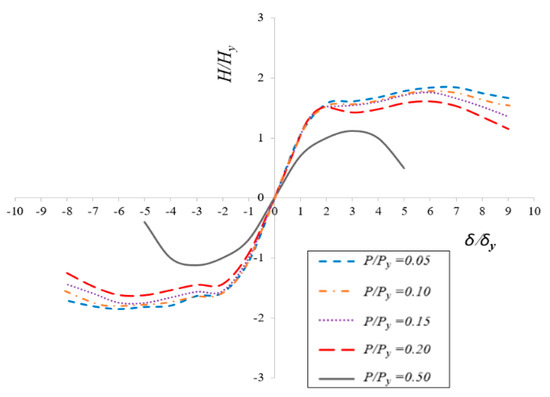
Figure 10.
Effect of P/Py on strength and ductility.
5.4. Post-Buckling Behavior of the Columns
The post-buckling behavior of the columns was analyzed, with Figure 11 illustrating the variation in maximum strength and deformation for each column. The analysis revealed that columns with lower values of Rf and P/Py exhibited higher maximum lateral strength and lateral deformation. To accurately capture failure and assess critical strength and ductility, a failure criterion corresponding to 95% of the maximum strength was used to define the post-buckling behavior [39,44,46]. This threshold represents the failure point beyond which the column is considered damaged and unable to support additional load, requiring retrofitting or replacement. Post-buckling strength and deformation values decreased as Rf and P/Py increased for all columns.
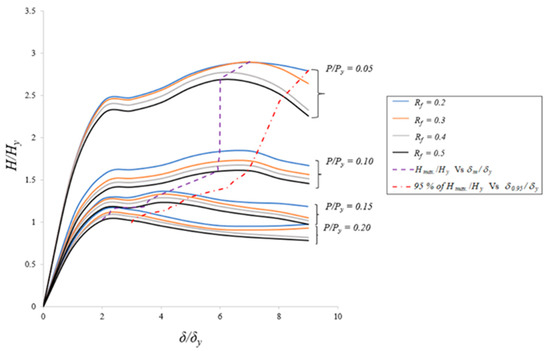
Figure 11.
Post buckling strength and ductility of the columns.
6. Proposed Design Equations
The ultimate strengths and ductility of 40 analyzed columns were determined through finite element (FE) analysis using the 2SM for material nonlinearity in ABAQUS. Figure 12 plots Hm/Hy against the integrated parameters (1 + P/Py)⋅Rf⋅λ, considering the interaction between Rf, λ, and P/Py on column strength. The best-fitting equation relating to the computed ultimate strength is given by:
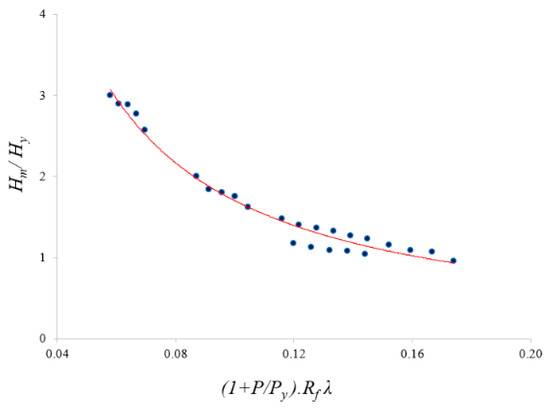
Figure 12.
The ultimate strength of the analyzed columns.
As shown in Figure 12, the ultimate strength improved as the integrated parameters (1 + P/Py)⋅Rf⋅λ, decreased. For this study, failure of the thin-walled stiffened steel box columns was considered to occur at a displacement equal to either δm or δ0.95. Here, δm represents the maximum displacement corresponding to Hm/Hy, while δ0.95 is the displacement at which post-peak strength drops to 95% of Hm/Hy. These normalized parameters are key to evaluating the ductile behavior of the columns. The δ0.95/δy parameter was used to analyze ductility, as column strength significantly deteriorates after this point due to local buckling.
As shown in Figure 12, the ultimate strength improved as the integrated parameters (1 + P/Py)⋅Rf⋅λ, decreased. For this study, failure of the thin-walled stiffened steel box columns was considered to occur at a displacement equal to either δm or δ0.95. Here, δm represents the maximum displacement corresponding to Hm/Hy, while δ0.95 is the displacement at which post-peak strength drops to 95% of Hm/Hy. These normalized parameters are key to evaluating the ductile behavior of the columns. The δ0.95/δy parameter was used to analyze ductility, as column strength significantly deteriorates after this point due to local buckling.
Figure 13a,b illustrate a reduction in both maximum deformation and post-buckling deformation as (1 + P/Py)⋅Rf⋅λ and Rf⋅λ increased. Additionally, ductility equations were proposed:
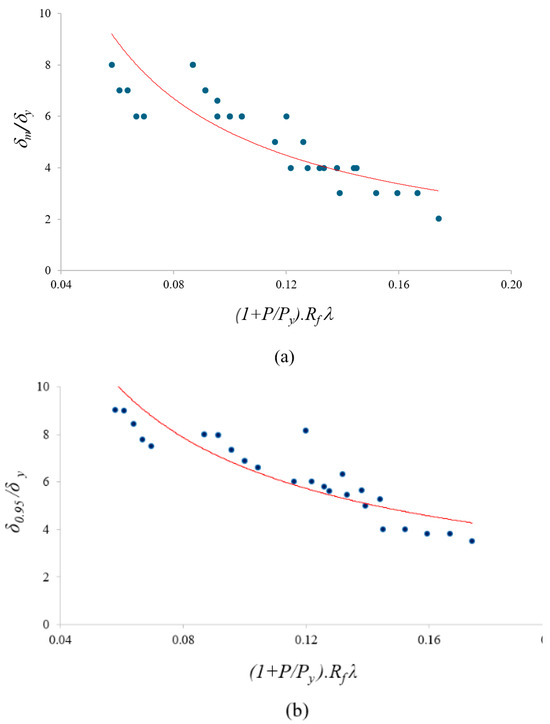
Figure 13.
(a) Ductility of the analyzed columns: (a) (δm/δy) vs. (1 + P/Py)·Rf·λ, and (b) (δ0.95/δy) vs. (1 + P/Py)·Rf·λ.
Equations (10) and (11) were derived from the design parameters to determine maximum deformation and post-buckling deformation, respectively, within the ranges 0.2 ≤ Rf ≤ 0.50, 0.2 ≤ λ ≤ 0.50, and P/Py ≤ 0.2. These limits for parameters are in the practical range for bridge design [44,46].
Application of the Proposed Design Equations
To verify the proposed design equations, two columns were designed and analyzed using ABAQUS-2SM: Column-1 with P/Py = 0.15, Rf = 0.35, and λ = 0.25; and Column-2 with P/Py = 0.18, Rf = 0.30, and λ = 0.30. The verification results are shown in Table 4. Figure 14a,b present the FE analysis results for Columns 1 and 2, respectively. The strength was predicted with 92% accuracy, while maximum deflection and post-buckling deflections were predicted with 94% accuracy. This study thus establishes practical equations for engineers to use in designing and constructing thin-walled, stiffened square box columns for bridge piers.

Table 4.
Results for design verification.
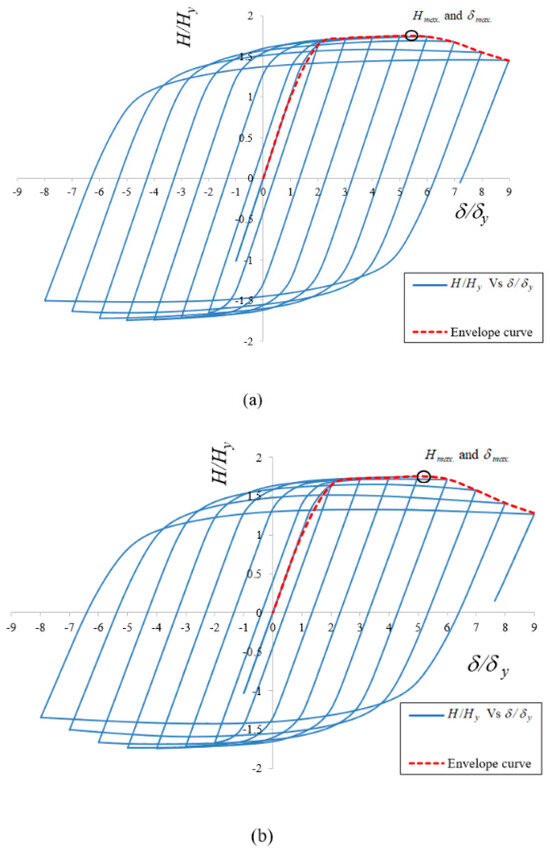
Figure 14.
(a) FE results for Column 1 (δm/δy), (b) FE results for Column 2 (δm/δy).
7. Conclusions
This study examined the cyclic behavior of prismatic thin-walled, stiffened steel square box columns, which model bridge piers, using finite element (FE) analysis with the commercial software ABAQUS, focusing on local, global, and local-global interactive buckling phenomena. The analysis employed the 2SM model to capture material nonlinearity under cyclic loading. The 2SM model offers a more accurate representation of the cyclic elastoplastic behavior of structural steel compared to existing material models in ABAQUS. It effectively incorporates cyclic effects within the yield plateau, accounting for their reduction and eventual disappearance, as well as the cyclic strain hardening of the material. Key design parameters investigated included the width-to-thickness ratio (Rf), the slenderness ratio (λ), and the axial load ratio (P/Py). The study led to the following conclusions:
FE Analysis Accuracy: The FE analysis using ABAQUS and the 2SM model (implemented via a UMAT subroutine) accurately captured column behavior under cyclic loading, closely matching experimental results. The thin-walled columns showed minimal variation when the FE model included a multi-linear kinematic hardening model. Local buckling was observed in thin-walled steel tubes, with geometric attributes influencing cyclic behavior more than material non-linearities, especially for thin-walled sections susceptible to local buckling. Significant differences in strength and ductility were found in compact columns when using different material models, as the material nonlinearity governs the column behavior in the absence of local buckling.
Effect of Axial Loads: Axial loads up to 20% of the yield load (Py) had a negligible effect on the ultimate strength of the columns. However, higher axial loads (exceeding 30% of Py) significantly lowered buckling, post-buckling, and ductility of the impacted columns.
Parametric Study Results: The ultimate lateral strength of thin-walled, stiffened steel square box columns was achieved when lateral displacement reached 5δy. Beyond this point, strength decreased due to the local buckling of the component plates. Increasing both Rf and λ resulted in lower ultimate lateral strength and ductility.
Design Equations: New design equations were introduced to predict ultimate lateral strength, maximum lateral displacement, and post-buckling displacement. These equations offer a practical approach for designing thin-walled, stiffened steel square box columns for bridge piers.
Validation of Design Equations: To validate the proposed design equations, two columns were designed, and their ultimate lateral strength and displacement values were confirmed through FE analysis. The design equations achieved 95% accuracy in predicting ultimate lateral strength and 97% accuracy in predicting ultimate lateral displacements. The discrepancies between the FE predictions and experimental results were 5% for strength and 3% fortool ductility.
Author Contributions
Conceptualization, I.H.P.M.; Methodology, I.H.P.M.; Software, I.H.P.M.; Validation, M.N. and I.H.P.M.; Formal analysis, M.N. and I.H.P.M.; Investigation, I.H.P.M.; Resources, I.H.P.M.; Data curation, M.N. and I.H.P.M.; Writing—original draft, M.N. and I.H.P.M.; Writing—review & editing, I.H.P.M.; Visualization, M.N. and I.H.P.M.; Supervision, I.H.P.M.; Project administration, I.H.P.M.; Funding acquisition, I.H.P.M. All authors have read and agreed to the published version of the manuscript.
Funding
This research received no external funding.
Institutional Review Board Statement
Not applicable.
Informed Consent Statement
Not applicable.
Data Availability Statement
The data presented in this study are available on request from the corresponding author.
Conflicts of Interest
The authors declare no conflict of interest.
References
- EN 10219-1; Cold-Formed Welded Structural Hollow Sections of Non-Alloy and Fine-Grain Steels. Technical Delivery Requirements; European Committee for Standardization (CEN): Brussels, Belgium, 2006.
- Usami, T. Interim Guidelines and New Technologies for Seismic Design of Steel Structures; Committee on New Technology for Steel Structures, Japanese Society of Civil Engineers: Tokyo, Japan, 1996. (In Japanese) [Google Scholar]
- Nishikawa, K.; Yamamoto, S.; Natori, T.; Terao, K.; Yasunami, H.; Terada, M. Retrofitting for Seismic Upgrading of Steel Bridge Columns. Eng. Struct. 1998, 20, 540–551. [Google Scholar] [CrossRef]
- Kawashima, K.; Hasegawa, K.; MacRae, G.A.; Ikeuchi, T. Ductility of Steel Bridge Piers from Dynamic Loading Tests. In Stability of Steel Structures under Cyclic Loading; Fukumoto, T., Lee, G.C., Eds.; CRC Press: Boca Raton, FL, USA, 1992. [Google Scholar]
- MacRae, G.A.; Kawashima, K. Estimation of the Deformation Capacity of Steel Bridge Piers. In Stability of Steel Structures under Cyclic Loading; Fukumoto, T., Lee, G.C., Eds.; CRC Press: Boca Raton, FL, USA, 1992. [Google Scholar]
- Mamaghani, I.H.P. Cyclic Elastoplastic Behavior of Steel Structures: Theory and Experiments. Ph.D. Dissertation, Nagoya University, Nagoya, Japan, 1996. [Google Scholar]
- Meng, X.; Whitfield, S.; Boudjabeur, S.; Gardner, L. Stability of Hot-finished and Cold-formed Steel Hollow Section Columns: A Comparative Study. Structures 2024, 68, 107192. [Google Scholar] [CrossRef]
- Rondal, J.; Maquoi, R. Stub-Column Strength of Thin-walled Square and Rectangular Hollow Sections. Thin-Walled Struct. 1985, 3, 15–34. [Google Scholar] [CrossRef]
- Meng, X.; Gardner, L. Cross-sectional Behaviour of Cold-formed High Strength Steel Circular Hollow Sections. Thin-Walled Struct. 2020, 156, 106822. [Google Scholar] [CrossRef]
- Yang, L.; Yin, F.; Wang, J.; Bilal, A.; Ahmed, A.H.; Lin, M. Local Buckling Resistances of Cold-formed High-Strength Steel SHS and RHS with Varying Corner Radius. Thin-Walled Struct. 2022, 172, 108909. [Google Scholar] [CrossRef]
- Wang, J.; Afshan, S.; Schillo, N.; Theofanous, M.; Feldmann, M.; Gardner, L. Material Properties and Compressive Local Buckling Response of High Strength Steel Square and Rectangular Hollow Sections. Eng. Struct. 2017, 130, 297–315. [Google Scholar] [CrossRef]
- Ma, J.L.; Chan, T.M.; Young, B. Experimental Investigation on Stub-column Behavior of Cold-formed High-Strength Steel Tubular Sections. J. Struct. Eng. 2016, 142, 04015174. [Google Scholar] [CrossRef]
- Wang, J.; Gardner, L. Flexural Buckling of Hot-finished High-strength Steel SHS and RHS Columns. J. Struct. Eng. 2017, 143, 04017028. [Google Scholar] [CrossRef]
- Zhao, O.; Gardner, L.; Young, B. Testing and Numerical Modelling of Austenitic Stainless Steel CHS Beam-Columns. Eng. Struct. 2016, 111, 263–274. [Google Scholar] [CrossRef]
- Goto, Y.; Koyama, R.; Fujll, Y.; Obata, M. Ultimate State of Thin-Walled Stiffened Rectangular Steel Columns under Bi-Directional Seismic Excitations. Doboku Gakkai Ronbunshuu A 2009, 65, 61–80. [Google Scholar] [CrossRef][Green Version]
- Meng, X.; Gardner, L. Flexural Buckling of Normal and High Strength Steel CHS Columns. Structures 2021, 34, 4364–4375. [Google Scholar] [CrossRef]
- Meng, X.; Gardner, L. Behavior and Design of Normal-and High-strength Steel SHS and RHS Columns. J. Struct. Eng. 2020, 146, 04020227. [Google Scholar] [CrossRef]
- Huang, Y.; Young, B. Structural Performance of Cold-formed Lean Duplex Stainless Steel Columns. Thin-Walled Struct. 2014, 83, 59–69. [Google Scholar] [CrossRef]
- Pournara, A.E.; Karamanos, S.A.; Mecozzi, E.; Lucci, A. Structural Resistance of High-strength Steel CHS Members. J. Constr. Steel Res. 2017, 128, 152–165. [Google Scholar] [CrossRef]
- Zhao, O.; Gardner, L.; Young, B. Behaviour and Design of Stainless Steel SHS and RHS Beam-columns. Thin-Walled Struct. 2016, 106, 330–345. [Google Scholar] [CrossRef]
- Poursadrollah, A.; D’Aniello, M.; Landolfo, R. Experimental and Numerical Tests of Cold-formed Square and Rectangular Hollow Columns. Eng. Struct. 2022, 273, 115095. [Google Scholar] [CrossRef]
- Yuan, H.X.; Wang, Y.Q.; Gardner, L.; Shi, Y.J. Local-overall Interactive Buckling of Welded Stainless-Steel Box Section Compression Members. Eng. Struct. 2014, 67, 62–76. [Google Scholar] [CrossRef]
- Yang, L.; Shi, G.; Zhao, M.; Zhou, W. Research on interactive buckling behavior of welded steel box-section columns. Thin-Walled Struct. 2017, 115, 34–47. [Google Scholar] [CrossRef]
- Schillo, N.; Feldmann, M. Interaction of local and global buckling of box sections made of high strength steel. Thin-Walled Struct. 2018, 128, 126–140. [Google Scholar] [CrossRef]
- Fukumoto, Y. Cyclic Performance Assessment of Stiffened Box Columns with Thickness Tapered Plates. In Proceedings of the 2004 Annual Stability Conference, SSRC, Long Beach, CA, USA, 24–27 March 2004; SSRC 2004 Beedle Award Paper. pp. 1–18. [Google Scholar]
- Key, P.W.; Hasan, S.W.; Hancock, G.J. Column Behavior of Cold-formed Hollow Sections. J. Struct. Eng. 1988, 114, 390–407. [Google Scholar] [CrossRef]
- Zhou, F.; Huang, L.; Li, H.T. Cold-Formed Stainless Steel SHS, and RHS Columns Subjected to Local-flexural Interactive Buckling. J. Constr. Steel Res. 2022, 188, 106999. [Google Scholar] [CrossRef]
- Yin, F.; Wang, J.; Yang, L.; Kang, N.; Elliott, F. Testing and Design of Cold-formed High Strength Steel Square Hollow Section Columns. J. Constr. Steel Res. 2024, 213, 108394. [Google Scholar] [CrossRef]
- Zhang, X.Z.; Liu, S.; Zhao, M.S.; Chiew, S.P. Comparative Experimental Study of Hot-formed, Hot-finished, and Cold-formed Rectangular Hollow Sections. Case Stud. Struct. Eng. 2016, 6, 115–129. [Google Scholar] [CrossRef]
- Japanese Road Association (JRA). Specification for Highway Bridges; Part V; Japanese Road Association (JRA): Tokyo, Japan, 1996. (In Japanese) [Google Scholar]
- Mamaghani, I.H.P. Seismic Design and Ductility Evaluation of Thin-Walled Steel Bridge Piers of Box Sections. Transp. Res. Rec. J. Transp. Res. Board 2008, 2050, 137–142. [Google Scholar] [CrossRef]
- Bruneau, M. Performance of steel bridges during the 1995 Hyogoken–Nanbu (Kobe, Japan) Earthquake—A North American Perspective. Eng. Struct. 1998, 20, 1063–1078. [Google Scholar] [CrossRef]
- Gao, S.B.; Ge, H.B. Numerical Simulation of Hollow and Concrete-filled Steel Columns. Adv. Steel Constr. 2007, 3, 668–678. [Google Scholar]
- Li, H.; Gao, X.; Liu, Y.; Luo, Y. Seismic Performance of New-type Box Steel Bridge Piers with Embedded Energy-Dissipating Shell Plates under Tri-directional Seismic Coupling Action. Int. J. Steel Struct. 2017, 17, 105–125. [Google Scholar] [CrossRef]
- Gao, S.B.; Usami, T.; Ge, H.B. Ductility Evaluation of Steel Bridge Piers with Pipe Sections. J. Eng. Mech. 1998, 124, 260–267. [Google Scholar] [CrossRef]
- Chiew, S.P.; Lee, S.L.; Shanmugam, N.E. Experimental Study of Thin-walled Steel Box Columns. J. Struct. Eng. 1987, 113, 2208–2220. [Google Scholar] [CrossRef]
- Dewolf, J.T.; Pekoz, T.; Winter, G. Local and Overall Buckling of Cold-formed Members. J. Struct. Eng. 1974, 100, 2017–2036. [Google Scholar] [CrossRef]
- Kitada, T.; Nakai, H.; Matsumura, M.; Kagayama, T. Experimental Study on Seismic Retrofitting Method of Stiffened Plates in Existing Steel Bridge Piers under Cyclic Loading. J. Struct. Eng. 2000, 46, 127–134. (In Japanese) [Google Scholar]
- Al-Kaseasbeh, Q.; Mamaghani, I.H.P. Buckling Strength and Ductility Evaluation of Thin-Walled Steel Tubular Columns with Uniform and Graded Thickness under Cyclic Loading. J. Bridge Eng. 2019, 24, 04018105. [Google Scholar] [CrossRef]
- Mamaghani, I.H.P.; Njiru, M. Buckling Strength of Cold-Formed Stiffened Thin-Walled Steel Box Bridge Piers under Cyclic Loading. Ce/Papers 2023, 6, 1291–1294. [Google Scholar] [CrossRef]
- Mamaghani, I.H.P.; Njiru, M. Strength and Ductility Evaluation of Thin-walled Steel Tubular Bridge Piers under Cyclic Loading. In Proceedings of the International Structural Engineering and Construction, Chicago, IL, USA, 14–18 August 2023; Volume 10. [Google Scholar] [CrossRef]
- Fukumoto, Y. Structural Stability Design—Steel and Composite Structures; Pergamon Press: Oxford, UK, 1997. [Google Scholar]
- Fukumoto, Y.; Uenoya, M.; Nakamura, M.; Saya, H. Cyclic Performance of Stiffened Square Box Columns with Thickness Tapered Plates. Steel Struct. 2003, 3, 107–115. [Google Scholar]
- Zheng, Y.; Usami, T.; Ge, H. Ductility of Thin-Walled Steel Box Stub-Columns. J. Struct. Eng. 2000, 126, 1304–1311. [Google Scholar] [CrossRef]
- Tran, K.L.; Douthe, C.; Sab, K.; Dallot, J.; Davaine, L. Buckling of Stiffened Curved Panels under Uniform Axial Compression. J. Constr. Steel Res. 2014, 103, 140–147. [Google Scholar] [CrossRef]
- Usami, T.; Gao, S.; Ge, H. Elastoplastic Analysis of Steel Members and Frames Subjected to Cyclic Loading. Eng. Struct. 2000, 22, 135–145. [Google Scholar] [CrossRef]
- Lyu, F.; Goto, Y.; Kawanishi, N.; Xu, Y. Three-dimensional Numerical Model for Seismic Analysis of Bridge Systems with Multiple Thin-Walled Partially Concrete-Filled Steel Tubular Columns. J. Struct. Eng. 2020, 146, 04019164. [Google Scholar] [CrossRef]
- Ucak, A.; Tsopelas, P. Accurate Modeling of the Cyclic Response of Structural Components Constructed of Steel with Yield Plateau. Eng. Struct. 2012, 35, 272–280. [Google Scholar] [CrossRef]
- Nigel Priestley, M.J.; Kowalsky, M.J.; Calvi, G.M. Displacement-Based Seismic Design of Bridges. In Bridge Engineering Handbook, 2nd ed.; Chen, W.F., Duan, L., Eds.; CRC Press: Boca Raton, FL, USA, 2014; pp. 217–252. [Google Scholar] [CrossRef]
- Njiru, M.; Mamaghani, I.H.P. Inelastic Behavior of Thin-walled Circular Steel Tubular Columns under Pushover and Cyclic Loading. In Proceedings of the 7th International Conference on Civil, Structural and Transportation Engineering, Niagara Falls, ON, Canada, 5–7 June 2022. [Google Scholar] [CrossRef]
- Chatzopoulou, G.; Karamanos, S.A. Numerical Implementation of a Bounding-surface Model for Simulating the Cyclic Inelastic Response of Metal Piping Components. Finite Elem. Anal. Des. 2021, 185, 103493. [Google Scholar] [CrossRef]
- Smith, M. ABAQUS/Standard User’s Manual, Version 6.9; Dassault Systèmes: Providence, RI, USA, 2009; Available online: https://www.3ds.com/products-services/simulia/products/abaqus/ (accessed on 20 August 2024).
- Zienkiewicz, O.C. The Finite Element Method, 3rd ed.; McGraw-Hill: New York, NY, USA, 1977. [Google Scholar]
- Kassimali, A.; Prashant, A. Structural Analysis, 4th ed.; SI ed./Prepared by Amit Prashant; Cengage Learning: Stamford, CT, USA, 2011. [Google Scholar]
- Wang, W.; Zhang, C.; Li, Z.; Gan, X. A Study on the Application of Two Different Material Constitutive Models Used in the FE Simulation of the Cyclic Plastic Behavior of a Steel Beam-Column T-Stub Connection. Adv. Civ. Eng. 2021, 2021, 8868015. [Google Scholar] [CrossRef]
- Kim, D.K.; Dargush, G.F.; Shin, S.W.; Hu, J.W. A Two-surface Plasticity Model for the Simulation of Uniaxial Ratchetting Response. J. Mech. Sci. Technol. 2012, 26, 145–152. [Google Scholar] [CrossRef]
- Shen, C.; Tanaka, Y.; Mizuno, E.; Usami, T. A two-surface Model for Steels with Yield Plateau. Struct. Eng. 1992, 8, 179s–188s. [Google Scholar] [CrossRef]
- Shen, C.; Mamaghani, I.H.P.; Mizuno, E.; Usami, T. Cyclic Behavior of Structural Steels, II: Theory. J. Eng. Mech. 1995, 121, 1165–1172. [Google Scholar] [CrossRef]
- Banno, S.; Mamaghani, I.H.P.; Usami, T.; Mizuno, E. Cyclic Elastoplastic Large Deflection Analysis of Thin Steel Plates. J. Eng. Mech. 1998, 124, 363–370. [Google Scholar] [CrossRef]
Disclaimer/Publisher’s Note: The statements, opinions and data contained in all publications are solely those of the individual author(s) and contributor(s) and not of MDPI and/or the editor(s). MDPI and/or the editor(s) disclaim responsibility for any injury to people or property resulting from any ideas, methods, instructions or products referred to in the content. |
© 2024 by the authors. Licensee MDPI, Basel, Switzerland. This article is an open access article distributed under the terms and conditions of the Creative Commons Attribution (CC BY) license (https://creativecommons.org/licenses/by/4.0/).